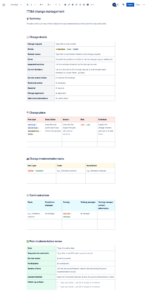Utilizing a pre-defined structure facilitates clear communication among stakeholders, reduces the risk of errors and omissions, and streamlines the change management lifecycle. This approach fosters improved efficiency in implementing changes while minimizing potential disruptions to ongoing IT operations and enhancing overall service stability.
The following sections will delve into the key components of such a document, exploring best practices for its creation and utilization within an effective change management process.
Key Components of an ITIL-aligned Change Request
Effective change management hinges on capturing comprehensive information about proposed modifications. A well-structured document facilitates this process by including essential details that enable thorough assessment and informed decision-making.
1. Unique Identifier: A distinct tracking number ensures easy reference and facilitates efficient management of the change throughout its lifecycle.
2. Change Title: A concise and descriptive title summarizes the nature of the proposed modification.
3. Change Initiator: Identifies the individual or team requesting the change.
4. Description of Change: A detailed explanation of the proposed modification, including its scope and objectives.
5. Justification for Change: The business rationale behind the proposed alteration, explaining the necessity and expected benefits.
6. Impact Assessment: Analysis of potential consequences, both positive and negative, on IT services, systems, and users.
7. Implementation Plan: Outlines the steps involved in executing the change, including timelines, resources, and rollback procedures.
8. Backout Plan: Details the steps required to revert the system to its previous state should the change fail or cause unexpected issues.
Capturing these essential elements provides a clear understanding of the proposed change, enabling thorough evaluations, informed decisions, and smooth implementation while mitigating potential risks.
How to Create an ITIL-aligned Change Request Template
Developing a standardized template ensures consistency and completeness in change documentation, facilitating effective change management. The following steps outline the process of creating a robust template.
1: Define Scope and Purpose: Determine the types of changes the template will cover. A separate template may be necessary for different categories of changes (e.g., standard, emergency).
2: Incorporate Key Fields: Include essential information fields such as a unique identifier, change title, initiator, description, justification, impact assessment, implementation plan, backout plan, testing procedures, and approval sections.
3: Establish Approval Workflows: Define the required authorization levels and incorporate designated approval fields within the template. This ensures appropriate oversight and accountability.
4: Design for Clarity and Usability: Use clear and concise language, logical formatting, and intuitive field labels. The template should be easy to understand and complete.
5: Pilot and Refine: Test the template with a small group of users to identify any areas for improvement. Gather feedback and refine the template based on real-world usage.
6: Implement and Train: Roll out the finalized template across the organization and provide training to ensure consistent application and understanding.
7: Regular Review and Updates: Periodically review and update the template to reflect evolving business needs and best practices. This ensures ongoing effectiveness and alignment with organizational objectives.
A well-designed template provides a structured framework for capturing comprehensive information about proposed changes. This structured approach reduces errors, improves communication, and facilitates informed decision-making, thereby contributing to a more robust and efficient change management process.
Standardized documentation provides a crucial foundation for effective IT change management within the ITIL framework. It enables comprehensive information gathering, facilitates thorough impact assessments, and promotes clear communication among stakeholders. A well-defined structure ensures consistency in documenting proposed modifications, fostering informed decision-making, and reducing the risk of errors and disruptions to IT services. This systematic approach supports successful implementation of changes, contributing to improved operational efficiency and enhanced service stability.
Organizations seeking to optimize their change management processes should prioritize the development and implementation of robust, ITIL-aligned documentation practices. This commitment to structured change management contributes significantly to minimizing risk, maximizing efficiency, and achieving desired business outcomes. A proactive approach to managing change is essential for navigating the evolving technological landscape and ensuring organizational agility and resilience.
